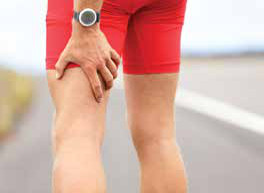
Many people who have played sports that require running—like soccer, football, field hockey and basketball—may have felt a twinge in the back of the leg, followed by pain of varying degrees and a tightening of the muscle. These symptoms are indicative of a hamstring injury. Rest assured, a full recovery from these types of injuries is possible, and we can help the process move smoothly and efficiently.
Hamstring muscles are located to the rear of the thigh muscle, starting at the pelvis and running behind the knee to the upper portion of the lower leg. Along with the quadriceps muscles, they allow the leg to extend and the knee to bend.
Injuries such as a “pulled hamstring” are common among athletes who participate in sports that require sprinting or the long extension of the hamstring muscles over an extended period of time. A pulled hamstring involves a strain, partial tear or full tear to one of the three hamstring muscles caused by muscle overload, typically due to an abrupt singular event.
If you have pulled your hamstring, we can design a program utilizing one or more of the following treatments, depending on your situation:
- Isometrics. This is a type of strength training that does not change the length of the muscle or the joint angle during muscle contraction. With isometrics, we can strengthen the muscle with a very specific range of motion that will minimize further injury and facilitate a speedier recovery.
- High-load eccentrics. Eccentric or “negative load” training requires muscles to resist force rather than exert it. It builds up muscle fibers, which in turn builds strength and re-establishes the “fast twitch” reaction.
- Resistance training. This treatment involves low-speed, high-load movements.
- Strength training. This is trainingwith the muscle stretched in a lengthened position.
If you have strained or torn a hamstring muscle, we can help you recover. After assessing your situation and reviewing treatment options with you, we will design a program that maximizes your recovery potential so that you can be back in action as soon as safely possible.









